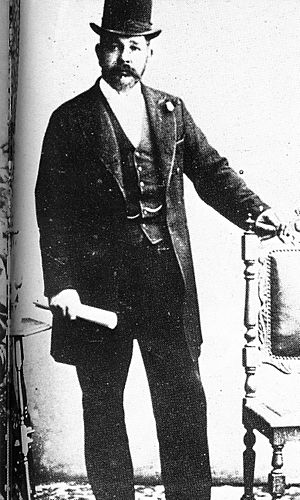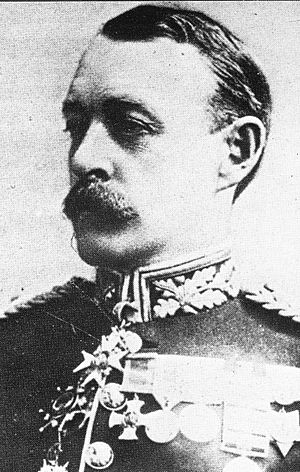Petrus Johannes Liebenberg facts for kids
Quick facts for kids
Petrus Johannes Liebenberg
|
|
|---|---|

Petrus Johannes Liebenberg (1857-1950), from Breytenbach 1983
|
|
| Born | September 29, 1857 Near Hoopstad |
| Died | March 5, 1950 (aged 92) |
| Allegiance | |
| Rank | Boer general |
| Battles/wars | First Boer War Second Boer War * Battle of Kraaipan * Battle of Modder River * Battle of Magersfontein * Siege of Mafeking * Battle of Diamond Hill |
Petrus Johannes Liebenberg (Piet Liebenberg, September 29, 1857 – March 5, 1950) was a brave Boer general. He fought in the Anglo-Boer War (1899–1902). This war was a big conflict in South Africa.
Contents
Early Life and First War
Petrus Liebenberg was born near Hoopstad in the Orange Free State. His parents were Christiaan Jacobus Liebenberg and Catharina Petronella van der Westhuizen.
In 1874, he lived on a farm called Witpoort. This farm was in the Klerksdorp district. Liebenberg took part in several military actions. He also fought in the First Boer War. In 1896, he became a representative for the Potchefstroom district. He served in the Second Volksraad parliament.
The Second Boer War Begins
When the Second Boer War started, Liebenberg joined the fight. He was at the western front. One of his first battles was the Battle of Kraaipan on October 12, 1899.
Later, he fought in the Battle of Modder River (November 28, 1899). He also took part in the Battle of Magersfontein (December 11, 1899). He then became a commander during the long Siege of Mafeking. This siege lasted from October 1899 to May 1900. In January 1900, he was promoted to a fighting general (veggeneraal).
Invading the Cape Colony
General Piet Cronjé gave Liebenberg an important order. He was to invade the Cape Colony. His mission was to damage the railway line. This railway was very important for the British army. It moved supplies and soldiers. Liebenberg also had to recruit more Boer men. These men were called "Cape rebels" or "new citizens." They would join the Boer republics.
Liebenberg left Cronjé's army camp in January 1900. He had about 200 men and two cannons. Other commanders, Koos Jooste and Andries de Wet, joined him. They wanted to destroy the railway near De Aar.
On February 15, 1900, Liebenberg's forces took over Prieska. They declared it part of the Orange Free State. Two days later, Cronjé urged them to attack the railway quickly. Liebenberg recruited 200 men in Griekwastad. He also chased away British troops near Britstown.
However, Liebenberg received a wrong order. His superior, General Jacob Johannes Marthinus Breytenbach, told him to retreat. Liebenberg obeyed this order. As a result, the British recaptured Prieska. The Cape rebels were left behind. Orange Free State President Marthinus Steyn fired Breytenbach. The plan to destroy the railway failed.
Return to the Cape Colony
After the British took Bloemfontein in March 1900, Liebenberg returned. He set up his headquarters at Rooidam. He was acting general for the Griqualand West area. In April 1900, more Boer fighters joined him.
British General Archibald Hunter forced Liebenberg to move north in May 1900.
The Relief of Mafeking
In May 1900, Liebenberg tried to stop British troops. These troops, led by Colonel B.T. Mahon, were trying to help Mafeking. Mafeking had been under siege for a long time. Liebenberg had about 450 men. He took a strong position near the Molopo River.
The Boer plan was to trap Mahon's troops. General Koos de la Rey was in charge of this plan. But during the battle, some Boer fighters retreated too soon. This created a gap. Mahon and his troops slipped through this gap. They entered Mafeking on May 17, 1900. This ended the 217-day siege.
Battles After Pretoria's Fall
After the British took Pretoria in June 1900, Boer commanders met. Liebenberg was there. They decided to keep fighting. They wanted to defend the mountain ridge east of Pretoria.
Liebenberg and his troops fought in the Battle of Diamond Hill. The Boers lost this battle. General Louis Botha ordered a retreat. Later, General De la Rey asked Liebenberg to join another invasion of the Cape Colony. Liebenberg agreed.
In July 1900, Liebenberg was given a Krupp cannon and a pom-pom gun. He commanded the Potchefstroom Commando. Generals Christiaan De Wet and Liebenberg combined their forces. They had 1500 men. They laid siege to Frederikstad in October 1900. But they had to flee when British reinforcements arrived.
Recognition for Service
In 1920, the government of the Union of South Africa honored Liebenberg. He was one of 590 Boer officers to receive a special medal. This medal was called the Dekoratie Voor Trouwe Dienst, Anglo-Boeroorlog, 1899-1902. It means "Decoration for Loyal Service." It was also known as the "Anglo-Boer War Medal."


